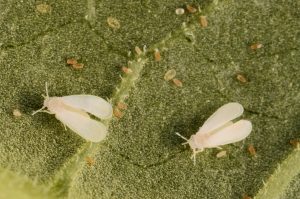
I walked by a ‘Gold Mound’ golden dewdrop in my front yard the other day and noticed something strange. Many of the leaves at the bottom where blackened and sticky looking. I looked closer and saw clouds of tiny white specks flying around the plant like a haze of smoke. I looked under the leaves and found them encrusted with white – a frosted texture like snow. Not to tell on myself, but I had broken my own rule of monitoring often to detect pest infestations while they are small and easy to control! Right under my nose, whiteflies had developed into a super colony of thousands! Oh well, I am only human, but you know that you are not having a good gardening day when you brush up against one of your plants and a talcum powder-white cloud of whiteflies takes flight. These annoying and persistent insects are potentially common on many garden plants. While whiteflies resemble true flies or tiny moths, they are actually in the same family as scale insects. Winged adults can come and go, but their immature forms are stationary and scale-like. Whiteflies mean trouble, but we can deal with them with time and knowledge.
How can something so small, fragile, and fluffy be a problem to our plants? We can have three generations of whiteflies every year in Florida. Eggs hatch in four to twelve days into a tiny stage called a “crawler” which moves about for only a couple of hours until it settles down to feed with its piercing-sucking mouthparts. The immature whitefly stays put for some time (weeks to months) and finally enters a resting stage prior to emerging as an adult. These immature stages are transparent light green in color and are smaller than the head of a pin – hard to see on the underside of a green leaf!
Whiteflies will show signs of their presence. Feeding damage on the affected leaves appears pale or spotted – no chewing involved with this critter. Also, these insects secrete large amounts of a sticky waste product called “honeydew”. Glistening deposits of honeydew, as well as the subsequent growth of black “sooty mold”, will appear near an infestation. There may even be ants present feeding on the honeydew. Plants attractive to whiteflies include – in addition to golden dewdrops – allamandas, citrus, gardenias, ligustrum, viburnum and many, many annuals. In fact, whiteflies are sometimes brought in accidentally when new infested plants are introduced to your garden. Always carefully check new plants prior to bringing them into your landscape. You may even want to quarantine questionable plants for a while to make sure that no unintended introductions are being made.
Whiteflies can also introduce diseases such as viruses. The tomato yellow leaf curl virus is a common problem in home vegetables gardens. Infected whiteflies feed on tomatoes and transmit a virus that causes tomato plant leaves to curl and yellow resulting in unproductive tomato plants. Infected plants become reservoirs for more infections.

Once a whitefly infestation is noticed, control options should be determined. You may want to rogue (total physical removal) heavily infested plants of low value in order to quickly reduce whitefly populations. Also, check carefully for parasites. Certain parasitic wasps are known to control whiteflies. Look for parasitized immature whiteflies – adults are not affected. A parasitized immature may have an emergence hole present where the tiny wasp emerged. If this activity is detected, use no pesticides as this will only slow the control provided by these beneficial wasps. There is even what is called “friendly fungi” which attacks certain types of whiteflies on citrus. If pesticides are needed, use a least toxic material such as horticultural oils or insecticidal soaps – not in the heat of the day as damage can occur to the leaves – according to label recommendations. Make sure to read these pesticide labels carefully as some host plants may be sensitive to these materials.
While a swarm of whiteflies may be heartbreaking at first sight, control of these insects is possible. Be encouraged that whiteflies can be controlled – check early and often! For more information on all types of troublesome insect pests, or to ask a question, you can also call the Master Gardener Volunteer Helpdesk on Mondays, Wednesdays, and Fridays from 1 to 4 pm at 764-4340 for gardening help and insight into their role as an Extension volunteer. Ralph E. Mitchell is the Director/Horticulture Agent for UF/IFAS Extension – Charlotte County. He can be reached at 941-764-4344 or ralph.mitchell@charlottecountyfl.gov. Connect with us on social media. Like us on Facebook @CharlotteCountyExtension and follow us on Instagram @ifascharco.
Resources:
Buss E. A. (2013) Whiteflies on Landscape Ornamentals. The University of Florida Extension Service, IFAS.
Bostick, S. & Wyatt-Evens, C. (2021) Edible Gardening Series: Question of the Week – Tomato Yellow Leaf Curl Virus. The University of Florida Extension Service, IFAS – Sarasota County.
Kumar V., McKenzie, C. L., C. Mannion, Stocks, I., Smith, T., & Osborne, L. S. (2020) Rugose Spiraling Whitefly Aleurodicus rugioperculatus Martin (Hemiptera: Aleyrodidae). The University of Florida Extension Service, IFAS.
Duval MGV (2022) Whitefly, and Other June Pests in Jacksonville Gardens. The University of Florida Extension Service, IFAS – Duval County.
Williams, D. S. (2023) Friendly Citrus Fungus: More than Meets the Eye! The University of Florida Extension Service, IFAS – Gadsden County.
 0
0
